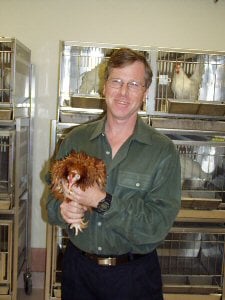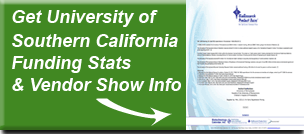 The University of Southern California has a thriving regenerative medicine research headquarters at the Broad Center within the Keck School of Medicine. Established in 2006, the Center's $80M state-of-the-art building opened in 2010 to house eleven research teams and four core laboratories. In addition to seeking out therapeutics, though, a team of USC stem cell scientists is marrying their study of stem cell functioning to a more thorough understanding of regenerative biology as it happens naturally in many species of animal. Drs. Cheng-Ming Chuong, Randall B. Widelitz (right), Ping Wu, and Ting-Xin Jiang of the Department of Pathology discuss their lab research, which looks at stem cells in hair and feathers in particular, in a recent article published in the journal Physiology.
The University of Southern California has a thriving regenerative medicine research headquarters at the Broad Center within the Keck School of Medicine. Established in 2006, the Center's $80M state-of-the-art building opened in 2010 to house eleven research teams and four core laboratories. In addition to seeking out therapeutics, though, a team of USC stem cell scientists is marrying their study of stem cell functioning to a more thorough understanding of regenerative biology as it happens naturally in many species of animal. Drs. Cheng-Ming Chuong, Randall B. Widelitz (right), Ping Wu, and Ting-Xin Jiang of the Department of Pathology discuss their lab research, which looks at stem cells in hair and feathers in particular, in a recent article published in the journal Physiology.
“Using the episodic regeneration of skin appendages as a clear readout, we have the opportunity to understand and modulate the behavior of adult stem cells and organ regeneration at a level heretofore unknown,” the authors say.
Stem cells always seem a bit miraculous, the stuff of science fiction, though of course they are very real and therapeutics are going to be a reality in our lifetimes, indeed some already are. (See our earlier blogs: Bioscience Medical Success Story using Harvard Bioscience's Stem Cell Technology System, and UCLA Stem Cell Research Restores Vision in Successful Trial Procedure.) While much current stem cell research focusses on how to obtain stem cells, how to pattern stem cells into organized tissues and organs, and how to deliver stem cell products to patients, there are still many questions to be answered about regeneration itself. The USC team says of their approach:
Here, we focus on “physiological regeneration” in which organs in higher vertebrates undergo episodic loss and regeneration under normal physiological conditions, whereas their organ stem cells undergo cycles of activation/quiescence.
In other words, they look at how stem cells in common hair and feathers turn on and off when they are doing what they do naturally, either repairing or regenerating themselves. Skin and organs also have some regenerative properties, and when we fully understand the physiological mechanism that governs and directs their rebuilding codes, therapies will be that much closer.
In related news, another stem cell research scientist at USC, Toshio Miki, M.D., Ph.D., has just received a $1.75M grant from the CIRM’s Early Translational Awards program. According to incoming Broad Center director Andrew McMahon:
“Dr. Miki has developed an exciting, innovative program, harnessing the potential of amniotic stem cells. I look forward to seeing this develop into a practical therapy for those suffering from liver disease.”
Biotechnology Calendar, Inc. will be holding its 7th annual USC BioResearch Product Faire FrontLine event on the Health Sciences campus October 3, 2012. This professional show is an excellent opportunity for life scientists and lab equipment specialists to come together and discuss lab technologies to make every lab run at its best. The USC Health Sciences event is one of three BCI tradeshows held over a three-day period in the greater Los Angeles area:
- 10/02/2012 -- 12th Annual BRPF event, UC Irvine
- 10/03/2012 -- 7th Semiannual Front Line event, University of Southern California, Health Sciences Campus
- 10/04/2012 -- 29th Semiannual BVS event, UCLA
For more information on exhibiting at USC Health Sciences, click the button below. Explore our website and see the complete 2012 Show Schedule, then give one of our sales associates a call.


